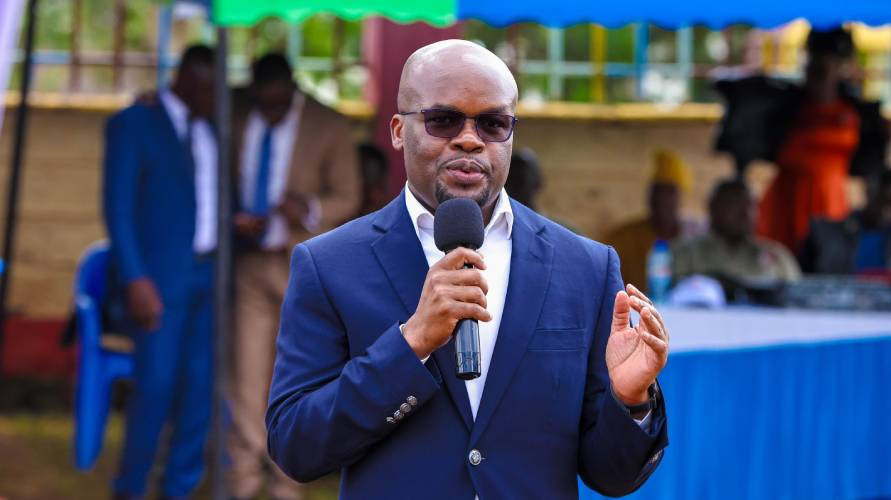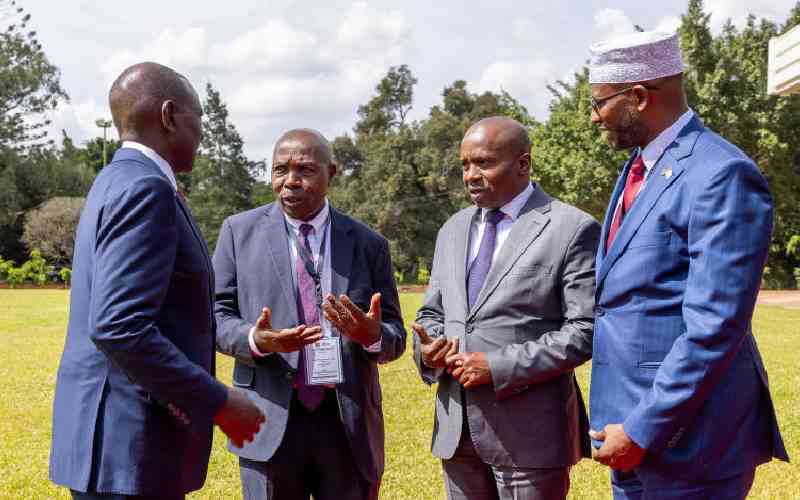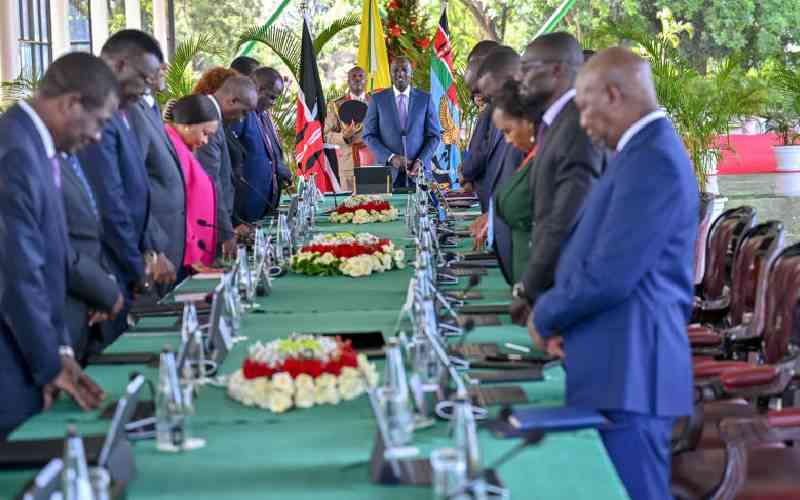Do you want to know which county has the widest disparity between the rich and poor? Would it intrigue you to discover which of the regional administrative units has the highest spending power?
The answers to your questions on livelihood and comfort levels or lack thereof, lie in a socio-economic atlas of Kenya released yesterday, showing the cluster of wealth, bowels of poverty and the density of population across the country. Not surprisingly given past reports, it reveals the shocker that the average wealth gap is 76.2 per cent.
Launched by Devolution Cabinet Secretary Anne Waiguru, the atlas shows that the wealth gap between the rich and the poor is the biggest in Nairobi where the average spending of the well-endowed is more than double that of the poor. Lamu, Kiambu, Kirinyaga and Mombasa are other counties leading in the wealth gap.
It is described as how far above the poverty line people in a given area live or how much more a non-poor person in a certain area spends in comparison with someone living on the poverty line.
Turkana, Mandera, Wajir, Marsabit and Samburu are the counties with the least wealth gap because even residents considered to be fairing well are very close to the poverty line and very vulnerable to falling into poverty in the event of drought, reduced market access or price fluctuations.
According to the atlas released yesterday, people in Nairobi and four other counties spend many times over what poor people budget for their essential goods and services.
In Nairobi, the average spending by the wealthy is more than double (152 per cent) of what the poor allocate to meet basic needs like food, shelter and clothing.
In total, more than six counties, including Nyeri, have their well-to-do residents spending much more than double of what is at the disposal of the poor.
More than 20 million people in Kenya, about 55 per cent of the total population live above the poverty line and are thus categorised as non-poor. The average wealth gap of Kenya's non-poor is 76.2 per cent.
At the county level, the poverty gap is highest in Tana River County at 46 per cent at the sub-location level, as well as in Kwale, Mandera, Wajir and Kilifi meaning that people in these areas are far below the poverty line.
However, the counties with the least poverty gap are Nairobi, Kirinyaga, Kiambu, Meru and Uasin Gishu, meaning that poor people in these areas are close to the poverty line and may cross the line into being non-poor.
The poverty gap describes how far below the poverty line poor people in a certain area live. In other words an average poor person in the county would have to double his or her material means just to reach the poverty line.
In terms of the number of poor people in a particular area, Nairobi, Kiambu, Kirinyaga, Nyeri and Meru have the lowest, while Turkana, Mandera, Wajir, Marsabit and Tana River had the highest fraction of the population living below the poverty line
In some sub-locations in big cities, the poverty rate is zero per cent, meaning no one there is considered poor. At the other extreme, some sub-locations in remote areas have poverty rates of 100 per cent meaning everyone there is considered poor.
And the atlas of Kenya's population reveals that only seven counties out of the 47 do not have a majority ethnic community that exceeds 50 per cent or more.
The atlas, which depicts the population census by county and sub-locations, reveals that Nairobi and Mombasa are among those that do not have a dominant ethnic community exceeding 50 per cent.
Stay informed. Subscribe to our newsletter
Others are Marsabit, Lamu, Narok, Tana River and Isiolo. The rest of the counties have one dominant community that forms more than half of the population.
In Nairobi, the majority ethnic community - the Kikuyu - forms 29.4 per cent of the population followed by the Kamba and the Luo while in Mombasa County, the Mijikenda form 30.2 per cent followed by Kambas and Luos.
In Marsabit, the largest community, the Gabra, form 28 per cent followed by the Borana and Rendille while in Tana River, the largest community is the Pokomo with 28.2 per cent of the population followed by the Orma and Warder. In Lamu County, the largest community, the Swahili, form 30 per cent of the population followed by the Kikuyu and Mijikenda.
In Isiolo, the Borana are the largest community with 36.9 per cent of the population followed by the Somali and Samburu while in Kajiado County, the Kalenjin are the largest community at 40 per cent followed by the Maasai and Kikuyu.
Counties in which the largest community enjoys only a slight majority over 50 per cent are Trans Nzoia where the Luhya community is at 52 per cent. In Embu County, the Embu community make up 50.4 per cent followed by the Mbeere and Kamba communities. In Nakuru County, the Kikuyu enjoy a slight majority of 52 per cent followed by the Kalenjin. In Nairobi and Mombasa, the ethnic diversity extends all the way to the sub-location level.
Birth rates
The atlas was officially unveiled by Waiguru and Swiss Ambassador to Kenya Jacques Pitteloud.
In terms of birth rates, the atlas revealed that counties in Central Kenya have the lowest birth rates with Murang'a and Kirinyaga recording the lowest rates at 23.5 and 26.8 live birth per 1,000 people.
Kajiado had the highest birth rates with 63.2 live births per 1,000 people while Nyamira, Mandera and Kericho follow with 56.5, 54.9, and 54.3 live births in clusters of 1,000 people respectively. In addition, fertility rates are lowest in Kirinyaga, Nyeri, Murang'a Kiambu and the cities of Nairobi and Mombasa. They are highest in the arid and semi-arid counties such as Mandera.
The atlas also reveals that only Nairobi County has more than 2 million people while nine counties have crossed the one-million mark, including Kakamega, Kiambu, Nakuru, Bungoma, Meru, Kisii, Kilifi, Machakos and Mandera in that order.
Interestingly, Mombasa County has not yet reached the one-million mark, while Mandera County is one of the driest counties that has crossed the million mark, making it the 10th largest ahead of Kisumu (position 13) and Mombasa (position 15) even though Mombasa and Kisumu are classified as cities.
Kitui, another largely arid and semi-arid county, falls short of the one-million mark by only 2,400 people. In Central, only Meru and Kiambu counties have crossed the million mark. The other counties have more than half a million people but less than a million.
The urban counties of Nairobi and Mombasa show the highest population densities with 4,429 and 4,206 respectively. Other densely populated counties are Kisii with 870 persons per square kilometre followed by Kiambu (630 persons), Kakamega (548), and Bungoma (452).
Mandera County has more than a million people but only 39 persons per square kilometre. Vihiga Kisii, Nyamira, Kakamega and Kiambu have population densities exceeding 500 persons per square kilometre.
 The Standard Group Plc is a
multi-media organization with investments in media platforms spanning newspaper
print operations, television, radio broadcasting, digital and online services. The
Standard Group is recognized as a leading multi-media house in Kenya with a key
influence in matters of national and international interest.
The Standard Group Plc is a
multi-media organization with investments in media platforms spanning newspaper
print operations, television, radio broadcasting, digital and online services. The
Standard Group is recognized as a leading multi-media house in Kenya with a key
influence in matters of national and international interest.
 The Standard Group Plc is a
multi-media organization with investments in media platforms spanning newspaper
print operations, television, radio broadcasting, digital and online services. The
Standard Group is recognized as a leading multi-media house in Kenya with a key
influence in matters of national and international interest.
The Standard Group Plc is a
multi-media organization with investments in media platforms spanning newspaper
print operations, television, radio broadcasting, digital and online services. The
Standard Group is recognized as a leading multi-media house in Kenya with a key
influence in matters of national and international interest.







